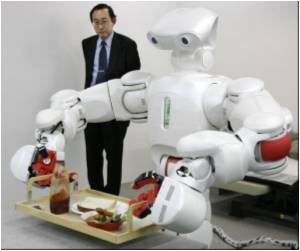Robots are being developed that can understand the joys and sorrows of dementia patients and cater to their needs. The robots will be human-like and perform a variety of tasks to lessen the burden of caregivers.
- Robots are being developed that are receptive to the joys and sorrows of dementia patients and cater to their needs accordingly
- These robots will have many human-like features, which are capable of performing multiple tasks
- They are likely to significantly reduce the work burden of caregivers
The findings were presented at the 14th Annual ACM/IEEE International Conference on Human Robot Interaction in Daegu, South Korea.
The study was led by Dr. Laurel Riek, PhD, who is an Associate Professor of Computer Science and Engineering at UCSD with joint appointments in the Department of Emergency Medicine and the Contextual Robotics Institute. She is also Director of the Healthcare Robotics Lab at UCSD.
Read More..
Drawbacks of Current Robots
The time and effort spent by caregivers of dementia patients is enormous. Mainly spouses and elder children provide 75 percent of the care to these patients. This is equivalent to 15 million people in the US alone, who provide more than 18 billion hours of work, having little time to spare for self-care. This poses a huge burden on caregivers. So, robots should ideally be able to reduce this burden.However, the current robotic technologies used in healthcare are designed to educate the caregivers rather than relieving some of the burdens. This is a major drawback. For example, these technologies have virtual support systems for facilitating interaction with doctors, who provide up-to-date information and expert advice to the caregivers, but not a helping hand.
What Type of Robots Do the Caregivers Envision?
The caregivers indicated that robots should fulfill the following major requirements:- Support the caregivers while sharing joyful moments with their patients
- Lessen the emotional stress of the caregivers during difficult situations, such as having to answer repetitive questions of the patients
- Relieve the caregivers from monotonous daily chores in patient care
- Provide alerts about daily schedules, duties, and tasks of the caregivers
- Assist with physiotherapy and administering medications
- Play the role of counselors and facilitators in day-to-day patient care
- Interact more-and-more with the patients as the disease progresses by assisting them in performing daily activities
Salient Features of the Study
- The study was carried out in collaboration with three Dementia Day Care Centers in San Diego County. The following are the important features of the study:
- A series of interviews and hands-on workshops were conducted for caregivers by UCSD researchers
- The study included the following participants:
- Thirteen family members who acted as caregivers
- Five social workers heading the daycare centers
- Three geriatric nursing students working at the centers
- Sixteen major challenges were identified by the caregivers, including difficulty in accepting and coping with dementia, isolation of the dementia patients, and planning care for themselves
- Workshops educated the caregivers about the five latest robots currently available:
- Pet robots
- Cleaning robots
- Telepresence robots
- Smart speakers
- Hands-free wearables
- The research team and caregivers co-designed the robots and built prototypes
- Various functionalities were incorporated into the robot prototypes, including the following:
- Gaming
- Reviewing photo albums
- Exercising
- Preventing patients from driving
- Facilitating patients to bathe
- Answering repetitive questions
- The robots were fitted with touch screens and voice command interfaces for easy communication with both caregivers and patients
What Should be the Ideal Characteristics of the Robots?
The research team developed a list of characteristics and formulated guidelines for designing an ideal robot for dementia patients, based on inputs from the caregivers. These are briefly highlighted below:- The robots should be programmed to tackle difficult and repetitive questions or change the subject
- It should be possible to integrate the robots with objects that are familiar to the dementia patients
- They should have the capacity to adapt to new situations as well as behavioral changes of the dementia patients
- The robots should be able to continuously learn from their owners and personalize their responses accordingly
- Human-like features should be incorporated in the robots, such as a human voice and human face, so that they can be more persuasive, build trust, and become friendly with the dementia patients
- Interaction with the dementia patients should be by voice activation and the voice should resemble that of a person close to the patient
- Facial recognition feature should be incorporated in the robots
Concluding Remarks
The research team is planning to build high-tech prototype robots, based on the current low-tech prototypes so that they can test their efficiency by deploying them in the homes of dementia patients.“It is imperative researchers take a community-health focused approach to understanding stakeholders’ perspectives prior to building the technology,” said Riek. “Especially in healthcare robotics - one should not walk in with a technology hammer.”
Reference:
- Robots for Joy, Robots for Sorrow: Community Based Robot Design for Dementia Caregivers - (https://cseweb.ucsd.edu/~lriek/papers/moharana-panduro-lee-riek-hri19.pdf)
Source-Medindia















